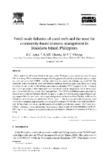| dc.contributor.author | Amar, Edgar | |
| dc.contributor.author | Cheong, R.M.T. | |
| dc.contributor.author | Cheong, M.V.T. | |
| dc.contributor.editor | Liao, David S. | |
| dc.date.accessioned | 2011-06-22T09:35:51Z | |
| dc.date.available | 2011-06-22T09:35:51Z | |
| dc.date.issued | 1995 | |
| dc.identifier.citation | Amar, E. C., Cheong, R. M. T., & Cheong, M. V. T. (1995). Small-scale fisheries and yield of coral reefs in Malalison Island, west central Philippines: Implications for a community-based coastal fishery resource management. In D. S. Liao (Ed.), International Cooperation for Fisheries and Aquaculture Development. Proceedings of the 7th Biennial Conference of the International Institute of Fisheries Economics and Trade: Vol. I (pp. 355–366). Institute of Fisheries Economics, National Taiwan Ocean University. | en |
| dc.identifier.uri | http://hdl.handle.net/10862/447 | |
| dc.description.abstract | Fish landings in Malalison Island on west central Philippines were monitored from February 1991 to January 1992 to determine the fishing gears employed, the predominant species caught, the catch per unit effort (CPUE), and the yield from the coral reefs. A total of 494 fishing operations were recorded; fishing was monitored only during spring tide periods. CPUE (kg man-hr-1) by gear was 1.10 for spear guns, 1.43 for spear guns with compressor, 0.43 for set gill nets, 2.37 for 'drive-in' gill nets, 1.15 for drift gill nets, 0.67 for hook and lines. The CPUEs of Malalison gears are comparable to those of other coral reef fisheries. Dominant species caught were fusiliers and surgeonfish for gill net, surgeonfish for spear gun, and snappers and groupers for hook and line. The fish yield from coral reefs was estimated to be 5.8 t km-2 yr-1 and this is similar to overexploited reefs in the Philippines. The yield is also among the lowest reported in the Philippines and elsewhere. On the basis of live coral cover, yield, and fishing effort, the Malalison reefs can be categorized as an intensively fished fishery showing serious habitat degradation. Community-based management and resource enhancement should be initiated to protect the fishery and keep its utilization sustainable. | en |
| dc.language.iso | en | en |
| dc.publisher | Institute of Fisheries Economics, National Taiwan Ocean University | en |
| dc.publisher | International Institute of Fisheries Economics and Trade | en |
| dc.subject | Fishery resource management -- Philippines -- Malalison Island | en |
| dc.subject | Coral reefs | en |
| dc.subject | Fishing gear | en |
| dc.subject | Catch statistics | en |
| dc.subject | Catch effort | en |
| dc.subject | Artisanal fishing | en |
| dc.subject | Yield | en |
| dc.subject | Philippines -- Malalison Island | en |
| dc.subject.lcc | VF SP 251 | |
| dc.title | Small-scale fisheries and yield of coral reefs in Malalison Island, west central Philippines: Implications for a community-based coastal fishery resource management | en |
| dc.type | Conference paper | en |
| dc.citation.spage | 355 | |
| dc.citation.epage | 366 | |
| dc.citation.conferenceTitle | International Cooperation for Fisheries and Aquaculture Development. Proceedings of the 7th Biennial Conference of the International Institute of Fisheries Economics and Trade | en |



